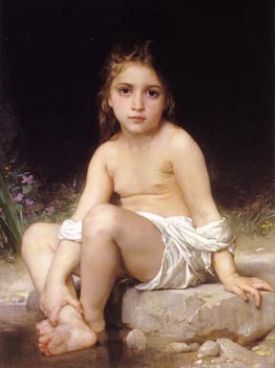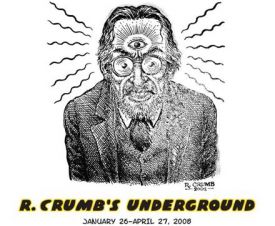Comics /
Comics News
R. Crumb's Underground
By Henry Chamberlain
March 16, 2008 - 00:01
R. Crumb's Underground
Frye Art Museum, Seattle, WA
January 26 thru April 27, 2008
Always Free to the Public
Well, it's true, some of the most fun stuff is right in your own backyard. So, there really was no excuse for me, a Seattle native, not to finally show up and take a look at the current Crumb exhibit at the Frye.
The art of Robert Crumb may offend you as well as amuse you and make you think. Take the work on display at this show and maybe you'll see America through the eyes of a great social critic and not a misogynist or a racist. This is Robert Crumb, warts and all. I have to say, ever since seeing glimpses of some Crumb art show in Terry Zwigoff's 1994 documentary, "Crumb," I have always wanted to see a wide-ranging exhibit of the man's work and this show fills the bill as well as helps to better understand suspicions raised in the film by some academics about Crumb's attitudes towards race and gender. After having a chance to take in the whole show, I am inclined to want to give Crumb the benefit of the doubt. But Crumb doesn't make it easy for anyone including museums.
A more receptive approach to Crumb may seem appropriate today but Crumb's work will surely touch a lot of raw nerves for quite some time to come and these issues may never be fully resolved. The curator for "R. Crumb's Underground," Yerba Buena Center's Todd Hignite is certainly sensitive to this and is most definitely focused on taking a respectful and perhaps needlessly reverential view of the artist's work as evidenced in this excerpt from the opening statement to the show: "Crumb's art offers a profound cultural critique filtered through demanding psychological self-reflection." Of course, at some point, you want the art to speak for itself. The first impression I got, as I viewed the initial specimens of vintage "Keep-On-Truckin" art, was of seeing work with vitality. Moving right along into the Frye's first display room for the show, it's not long before I'm studying something that could be welcomed by Caligula. The nihilistic orgy scenes of one kind or another are very well rendered in classic Crumb cross-hatch style and perfectly in tune with the darker side of the psychedelic free loving times of the '60s and '70s. The art involving black face stereotypes is challenging as well as something gaining acceptance as commenting on racism as opposed to being racist.
Then the main room, a fairly ample space of a couple of thousand square feet. Here you can see page after page of the master's work which includes compelling tributes to African-American blues, jazz, and country greats and touching family portraits. And to top it off, placed in the middle of the exhibit is Crumb's larger than life size sculpture of Devil Girl, a painted wood, epoxy, enamel creation of a sexually provocative contorted figure. As is the case with any show I've seen at the Frye, it does leave me wanting more. The museum is only so big and must, for legal reasons involving its trust, give over the lion's share of its space to its permanent collection, a mixed bag of 19th and 20th century realist paintings. The Crumb show falls in with the trust's demand to exhibit non-abstract art which, to the credit of the museum's leadership, has led to some very interesting interpretations of the trust's intentions. This traveling show is coordinated for the Frye by its director, Robin Held, who has been responsible for some wonderful shows such as the recent Mark Ryden retrospective.
The real problem I find with the Frye's handling of the show is the need to take things just one step further and assign some connections between the Crumb show and the museum's old chestnuts. There are three attempts made and they all don't make much sense. The first one I spotted was as I examined the Devil Girl sculpture. I was just about to walk on when I noticed this little placard with a little reproduction of one of the Frye's best-known paintings, "Sin," by Von Stuck, 1906. Okay, there's a tenuous connection at best here and one I wouldn't have bothered to make. The painting is of a seductress with a snake coiled around her. I spotted the next one after viewing a series of drawings called, "How to Have Fun with a Strong Woman," which illustrates Crumb engaged in various sexual positions with the woman of his dreams. Some of the drawings do look like Crumb has reached a holy experience. Enter the next Frye citation: a Frye painting of a crucifixion, "The Christian Martyr," 1867, by Ritter Von Max. No, I don't get it either.
 |
| Does this have anything to do with Robert Crumb? Ask the Frye Art Museum. |
Finally, upon return to the smaller exhibit space, I stopped to view, "Jail Bait of the Month: Honey Bunch Kaminski, 13, What a Little Yummy!" from Snatch #1, 1968, a cheesecake bare-breasted pin-up. To this, the Frye wishes to connect a Frye painting by Bouguereau of a naked little girl of about five, "Child at Bath," 1886. Seriously, I am not making this up. So, you wonder, what is the connection?! Well, it assumes that the Bouguereau painting, while pretending to be a homage to beauty, is actually close to crossing the line into child porn. This is the Frye's attempt to spice up the "artistic dialogue," but it is ill-conceived. Crumb is not hiding behind anything that arguably might be the case with Bouguereau. Whatever provocations on his part, Crumb is certainly upfront about it. That's the whole point about Crumb.
Crumb is an honest artist in the sense of not having a hidden agenda. Ultimately, his honesty is his saving grace. That and his intelligence, an intelligence needed to navigate through so much unbridled id gone wild. No doubt, there is quite a lot of strong material and it can be difficult to reconcile. His relation towards women in his work is problematic. There are endless examples of Crumb objectifying women but could this not be the honest howls at the moon of a man wrestling with his own demons as well as an expression of the limitations of modern man? That would seem fair. Or is it? Is Crumb getting away with something? He probably is as he has reached a point in his career where accolades outnumber criticisms. Getting to the bottom of Crumb is material for at least another book and does go beyond the scope of this review. For more insight into Crumb, I would start with a recent essay by Claire Litton at
Pop Matters.
Crumb does seem to be a special case and perhaps there is room for ambiguity in the big picture. Taking in his whole body of work, it can be said that he explores the depths of the dark as well as the light. An arguement can be made that the artist's desire for authenticity does ring true in his art. It does not ring true in the Frye's citations attempting to link their art to Crumb's. If Crumb were there to see his show at the Frye, and spotted those citations, he would most likely yank those labels right off at the first sight of them.
Last Updated: March 3, 2025 - 20:40

